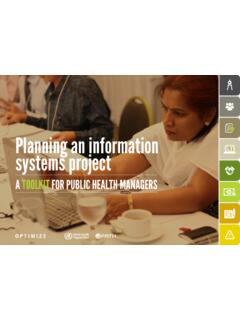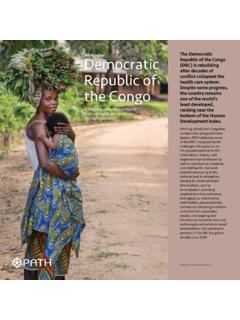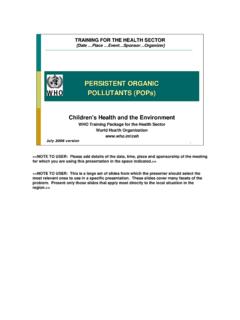Transcription of Procurement Assessment Guide - path.azureedge.net
1 Procurement Assessment Guide Contents A. Introduction B. Conducting a Procurement System Assessment C. Performance Indicators D. Procurement Assessment Questions E. Summarizing Assessment and Performance Indicator Findings F. Methodologies for Assessment of National Procurement Systems Procurement Assessment Guide Procurement Capacity Toolkit Procurement Assessment Guide -1 A. Introduction The purpose of the Procurement Assessment Guide is to provide designated assessors with a structured format to use for reviewing and evaluating the Procurement system in order to identify its strengths and weaknesses. Information from the Assessment and initial performance indicator results (see Section C for information regarding performance indicators) can then be used to develop a customized training program that draws on materials in the Procurement Capacity Toolkit.
2 The training program would help address the constraints of the Procurement system identified in the Assessment and strengthen the capacity of personnel to conduct competitive Procurement in accordance with internationally accepted good Procurement practices. The Procurement process does not occur in a vacuum. As presented in several Toolkit modules, supporting systems play an important role in contributing to the overall effectiveness of the Procurement process. These supporting systems include the timely provision of sound quantification data developed through the forecasting process; a budgeting and financial process that effectively allocates funds to support Procurement ; national policies and regulations that require open, competitive, and transparent bidding practices; and a national regulatory system that registers and regulates acceptable-quality medicines.
3 Information on these supporting systems has been included in the Toolkit so that Procurement personnel may better understand the overall supply process and how the different systems must coordinate activities and share information to ensure an effective Procurement process. However, while an effective Procurement system is closely tied to sound supporting systems, it is beyond the scope of the Toolkit to provide specific guidance on strengthening these supporting systems. The focus of the Procurement Assessment Guide is on identifying operational areas of performance that can be improved to strengthen specific Procurement practices, such as drafting specifications, preparing bidding documents, opening and evaluating supplier bids, awarding contracts, arranging for financing, and monitoring supplier performance.
4 Even though the focus is on operational Procurement , a general understanding of the larger environment that impacts Procurement system performance is helpful in designing a Procurement training program. In addition to questions on operational Procurement procedures and practices, this Assessment Guide contains a section on obtaining information on other components influencing the Procurement process. These components Procurement Assessment Guide Procurement Capacity Toolkit Procurement Assessment Guide -2 include national legislation governing Procurement practices; budgeting processes, financing procedures, and regulatory functions that support Procurement ; and systems that support the integrity and transparency of the Procurement process. The Assessment Guide is based on and draws significantly from the three major Procurement system Assessment methodologies (Organisation for Economic Co-operation and Development [OECD], World Bank, and the Global Fund to Fight AIDS, Tuberculosis and Malaria [Global Fund]) that are currently being used by international institutions to assess national Procurement systems.
5 Information on the general features of these methodologies is presented in Section F. Procurement Assessment Guide Procurement Capacity Toolkit Procurement Assessment Guide -3 B. Conducting a Procurement System Assessment Conducting a successful Procurement system Assessment requires careful advanced planning. Actions to be taken prior to the Assessment include: 1. Identifying the Information That Will Be Collected If an out-of-country organization is conducting the Assessment , prior desk research to answer some questions prior to the Assessment visit is highly recommended. Such desk research may include review of the country s Procurement act, national medicines policies, any buy local policy that may exist, and other regulations and guidelines. Prior Procurement assessments by funding agencies or other key stakeholders working in-country, such as midterm reviews and the World Bank Country Procurement Assessment Report, are a good place to start if such reports are available, as they will generally contain comprehensive information on the Procurement process.
6 The availability, reliability, and integrity of information and records need to be taken into account when planning an Assessment . Depending on the system being used, some data may not be available in particular countries; therefore, it is necessary to allow a certain amount of flexibility in conducting the Assessment . Lack of fundamental Procurement information and data, however, is a shortcoming in the system and needs to be identified as such in the Assessment report. A checklist of documents to collect during a Procurement system Assessment can be found in Annex 1. 2. Identifying the Stakeholders to Be Interviewed It is important to identify a range of stakeholders with different areas of knowledge about the system and varying perspectives on its effectiveness. This would include donors, government representatives of implementing and supporting agencies, and private-sector suppliers that compete for government Procurement opportunities.
7 Key stakeholders need to be identified and informed in advance of the purpose of the requested interviews. Procurement Assessment Guide Procurement Capacity Toolkit Procurement Assessment Guide -4 3. Identifying the Assessment Team The Assessment should be conducted by personnel with public Procurement experience and knowledge of operational Procurement and internationally accepted Procurement standards. If a third party is conducting the Assessment , it may be advantageous to include a counterpart from the government on the Assessment team to help arrange for logistics support and facilitate access to information. In addition, government participation plays an important role in building government support and commitment to implementing Assessment report 4. Reviewing the Assessment Methodology and Developing Performance Indicators Many of the Assessment questions allow for subjective professional judgment by the assessors.
8 While subjectivity cannot be fully removed from the Assessment , it is important for members of the Assessment team to discuss the Assessment process and attempt to establish a consistent approach in application of the methodology. It is also important at this time to develop a list of performance indicators that will be measured during the Assessment (see Section C for further information regarding performance indicators).1 Organisation for Economic Co-operation and Development. Methodology for Assessment of National Procurement Systems (Version 4). 2006. Available at: The User s Guide (Section 1) of this document provides very helpful guidance on conducting Procurement assessments. Procurement Assessment Guide Procurement Capacity Toolkit Procurement Assessment Guide -5 C.
9 Performance Indicators Performance indicators highlight key areas impacting overall performance within the Procurement process and are used to measure the success of capacity-building. They can also assist in identifying the details that an objective Procurement Assessment needs to look at. The establishment of performance indicators aids in the development of training curricula in terms of the type and length of training that needs to be conducted on specific Procurement areas that contribute to reaching the end goal. Performance indicators will not only alert the Assessment team to key problems, but will also play a vital role in tracking progress. Performance indicators need to be measurable; therefore, knowing where to access the data is important. In some country settings, certain documents might not exist, and in other cases, a third party might not be allowed access to confidential documents.
10 Although it may be unacceptable for a third party to review confidential documents, it may be possible for a government employee to verbally provide the information needed for the indicator. For example, an indicator may measure the difference between initial budget estimates and actual contracted costs to ascertain the accuracy of the budgeting process. While a third party might not be allowed to review a final contract and see actual supplier cost information, the cost data may be provided without naming the supplier. At the end of each Toolkit module, a suggested list of performance indicators has been provided based on the module subject. The indicators are provided as an example and should be adapted to country-specific situations. The complete listing of the suggested performance indicators can be found in Annex 2 of this Assessment Guide .












